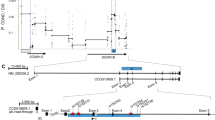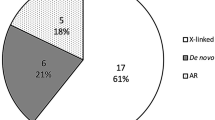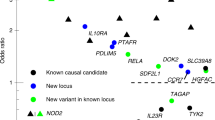Abstract
We have analyzed frequent naturally occurring variants in the autogene FAS in two independent cystic fibrosis (CF) patient populations. Analysis of FAS expression levels from intestinal epithelial biopsies from 16 unrelated F508del-CFTR homozygotes showed a correlation between FAS intron 2 SNP rs7901656 and signals for Affymetrix GeneChip U133 Plus 2.0 probeset 204781_s_at consistent with a dominant model (P=0.0009). Genotype and haplotype analysis at six informative SNPs spanning the FAS gene locus was carried out on 37 nuclear families representing extreme clinical phenotypes that were selected from the European CF Twin and Sibling Study population of more than 300 affected sibling pairs. Case–control comparison of the haplotype composed of rs2296603-rs7901656-rs1571019 encompassing intron 2 of FAS reached significance (P=0.0246). Comparative phylogenetic analysis and functional annotation of the FAS intron 2 sequence revealed a conserved non-coding sequence surrounding rs7901656 and predicted binding sites for four transcription factors whereby the binding site of c-Rel is altered by rs7901656. Taken together, these findings from two independent CF patient cohorts indicate that allelic variants within FAS intron 2 alter FAS gene expression and that these functional variants modulate the manifestation of CF disease.
This is a preview of subscription content, access via your institution
Access options
Subscribe to this journal
Receive 6 digital issues and online access to articles
$119.00 per year
only $19.83 per issue
Buy this article
- Purchase on Springer Link
- Instant access to full article PDF
Prices may be subject to local taxes which are calculated during checkout




Similar content being viewed by others
References
Bush A, Alton EWFW, Davies JC, Groesenbach U, Jaffe A . Cystic Fibrosis in the 21st Century 2006 Karger: Basel.
European Working Group on Cystic Fibrosis Genetics. Gradient of distribution in Europe of the major CF mutation and of its associated haplotype. Hum Genet 1990; 85: 436–445.
Johannsen HK, Nir M, Hoiby N, Koch C, Schwartz M . Severity of cystic fibrosis in patients homozygous and heterozygous for the deltaF508 mutation. Lancet 1991; 337: 631–634.
Mekus F, Ballmann M, Bronsveld I, Bijman J, Veeze H, Tümmler B . Categories of deltaF508 homozygous cystic fibrosis twin and sibling pairs with distinct phenotypic characteristics. Twin Res 2000; 3: 277–293.
Elizur A, Cannon CL, Ferkol TW . Airway inflammation in cystic fibrosis. Chest 2008; 133: 489–495.
Boucher RC . Cystic fibrosis: a disease of vulnerability to airway surface dehydration. Trends Mol Med 2007; 13: 231–240.
Tabary O, Escotte S, Couetil JP, Hubert D, Dusser D, Puchelle E et al. Relationship between IkappaBa deficiency, NFkappaB activity and interleukin-8 production in CF human airway epithelial cells. Pflügers Arch 2001; 443 (Suppl 1): S40–S44.
Saadane A, Soltys J, Berger M . Acute Pseudomonas challenge in cystic fibrosis mice causes prolonged nuclear factor-kappa B activation, cytokine secretion, and persistent lung inflammation. J Allergy Clin Immunol 2006; 117: 1163–1169.
Teichgräber V, Ulrich M, Endlich N, Riethmüller J, Wilker B, De Oliveira-Munding CC et al. Ceramide accumulation mediates inflammation, cell death and infection susceptibility in cystic fibrosis. Nat Med 2008; 14: 382–391.
Maiuri L, Raia V, De Marco G, Coletta S, de Ritis G, Londei M et al. DNA fragmentation is a feature of cystic fibrosis epithelial cells: a disease with inappropriate apoptosis? FEBS Lett 1997; 408: 225–231.
Cannon CL, Kowalski MP, Stopak KS, Pier GB . Pseudomonas aeruginosa—induced apoptosis is defective in respiratory epithelial cells expressing mutatnt cystic fibrosis transmembrane conductance regulator. Am J Respir Cell Mol Biol 2003; 29: 188–197.
Nagata S . FAS-ligand induced apoptosis. Annu Rev Genet 1999; 33: 29–55.
Grassme H, Kirschnek S, Riethmueller J, Riehle A, von Kürthy G, Lang F et al. CD95/CD95 ligand interactions on epithelial cells in host defense to Pseudomonas aeruginosa. Science 2000; 290: 527–530.
Stanke F, Becker T, Cuppens H, Kumar V, Cassiman JJ, Jansen S et al. The TNFalpha receptor TNFRSF1A and genes encoding the amiloride-sensitive sodium channel ENaC as modulators in cystic fibrosis. Hum Genet 2006; 119: 331–343.
Frazer KA, Pachter L, Poliakov A, Rubin EM, Dubchak I . VISTA: computational tools for comparative genomics. Nucleic Acids Res 2004; 32 (Web Server issue): W273–W279.
Huang Y, Kowalski D . WEB-THERMODYN: sequence analysis software for profiling DNA helical stability. Nucleic Acids Res 2003; 31: 3819–3821.
Araki K, Maeda H, Wang J, Kitamura D, Watanabe T . Purification of a nuclear trans-acting factor involved in the regulated transcription of a human immunoglobulin heavy chain gene. Cell 1988; 53: 723–730.
Feng W, Huang J, Zhang J, Williams T . Identification and analysis of a conserved Tcfap2a intronic enhancer element required for expression in facial and limb bud mesenchyme. Mol Cell Biol 2008; 28: 315–325.
Adams D, Karolak M, Robertson E, Oxburgh L . Control of kidney, eye and limb expression of Bmp7 by an enhancer element highly conserved between species. Dev Biol 2007; 311: 679–690.
Flodby P, Zhou B, Ann KD, Kim KJ, Minoo P, Cranddall ED et al. Conserved elements within first intron of aquaporin 5 (Aqp5) function as trabscritptional enhancers. Biochem Biophys Res Commun 2007; 336: 26–31.
Weickert CS, Miranda-Angulo AL, Wong J, Perlman WR, Ward SE, Radhakrishna V et al. Variants in the estrogen receptor alpha gene and its mRNA contribute to risk for schizophrenia. Hum Mol Genet 2008; 17: 2293–2309.
Scuteri A, Sanna S, Chen WM, Uda M, Albai G, Strait J et al. Genome-wide association scan shows genetic variants in the FTO gene are associated with obesity-related traits. PLoS Genet 2007; 3: e115.
Adams MD . Conserved sequences and the evolution of gene regulatory signals. Curr Opin Genet Dev 2005; 15: 628–633.
Gordan R, Hartemink AJ . Using DNA duplex stability information for transcription factor binding site discovery. Pac Symp Biocomput 2008; 13: 453–464.
Liu-Mares W, Sun Z, Bamlet WR, Atkinson EJ, Fridley BL, Slager SL et al. Analysis of variation in NF-kappaB genes and expression levels of NF-kappaB-regulated molecules. BMC Proc 2007; 1 (Suppl 1): S126.
Mountz JD, Talal N . Retroviruses, apoptosis and autogenes. Immun Today 1993; 14: 532–536.
Bidere N, Su HC, Lenardo MJ . Genetic disorders of programmed cell death in the immune system. Annu Rev Immunol 2006; 24: 321–352.
Kim R, Emi M, Tanabe K, Uchida Y, Toge T . The role of Fas ligand and transforming growth factor beta in tumor progression: molecular mechanisms of immune privilege via Fas-mediated apoptosis and potential targets for cancer therapy. Cancer 2004; 100: 2281–2291.
Peng SL . FAS(CD95)-related apoptosis and rheumatroid arthritis. Rheumatology 2006; 45: 26–30.
Lopatinskaya L, Zwemmer J, Uitdehaag B, Lucas K, Polman C, Nagelkerken L . Mediators of apoptosis Fas and FasL predict disability progression in multiple sclerosis over a period of 10 years. Mult Scler 2006; 12: 704–709.
Dockrell DH . The multiple roles of Fas ligand in the pathogenesis of infectious diseases. Clin Microbiol Infect 2003; 9: 766–779.
Hsu PI, Lu PJ, Wang EM, Ger LP, Lo GH, Tsay FW et al. Polymorphisms of death pathway genes FAS and FASL and risk of premalignant gastric lesions. Anticancer Res 2008; 28: 97–103.
Mekus F, Laabs U, Veeze H, Tümmler B . Genes in the vicinity of CFTR modulate the cystic fibrosis phenotype in highly concordant or discordant F508del homozygous sib pairs. Hum Genet 2003; 112: 1–11.
Becker T, Jansen S, Tamm S, Wienker TF, Tümmler B, Stanke F . Transmission ratio distortion and maternal effects confound the analysis of modulators of cystic fibrosis disease severity on 19q13. Eur J Hum Genet 2007; 15: 774–778.
Larkin MA, Blackshields G, Brown NP, Chenna R, McGettigan PA, McWilliam H et al. Clustal W and Clustal X version 2.0. Bioinformatics 2007; 23: 2947–2948.
Clamp M, Cuff J, Searle SM, Barton GJ . The Jalview Java alignment editor. Bioinformatics 2004; 20: 426–427.
Chekmenev DS, Haid C, Kel AE . P-Match: transcription factor binding site search by combining patterns and weight matrices. Nucleic Acids Res 2005; 33 (Web Server issue): W432–W437.
Knapp M, Becker T . Family-based association analysis with tightly linked markers. Hum Hered 2003; 56: 2–9.
Spielman RS, McGinnis RE, Ewens WJ . Transmission test for linkage disequilibrium: the insulin gene region and insulin-dependent diabetes mellitus (IDDM). Am J Hum Genet 1993; 52: 506–516.
Abecasis GR, Cookson WO . GOLD-graphical overview of linkage disequilibrium. Bioinformatics 2000; 16: 182–183.
Acknowledgements
We cordially thank Colin Davenport and Dr Jens Klockgether for their support in creating the alignments. VK was a member of the International Research Training Group Pseudomonas: Pathogenicity and Biotechnology (IRTG653 of the Deutsche Forschungsgemeinschaft). Financial support by the Deutsche Forschungsgemeinschaft (DFG SFB621-C7) is gratefully acknowledged.
Author information
Authors and Affiliations
Corresponding author
Additional information
Supplementary Information accompanies the paper on Genes and Immunity website (http://www.nature.com/gene)
Supplementary information
Rights and permissions
About this article
Cite this article
Kumar, V., Becker, T., Jansen, S. et al. Expression levels of FAS are regulated through an evolutionary conserved element in intron 2, which modulates cystic fibrosis disease severity. Genes Immun 9, 689–696 (2008). https://doi.org/10.1038/gene.2008.63
Received:
Revised:
Accepted:
Published:
Issue Date:
DOI: https://doi.org/10.1038/gene.2008.63
Keywords
This article is cited by
-
The CF-modifying gene EHF promotes p.Phe508del-CFTR residual function by altering protein glycosylation and trafficking in epithelial cells
European Journal of Human Genetics (2014)
-
Acute intratracheal Pseudomonas aeruginosa infection in cystic fibrosis mice is age-independent
Respiratory Research (2011)
-
Initial interrogation, confirmation and fine mapping of modifying genes: STAT3, IL1B and IFNGR1 determine cystic fibrosis disease manifestation
European Journal of Human Genetics (2011)
-
Hierarchical fine mapping of the cystic fibrosis modifier locus on 19q13 identifies an association with two elements near the genes CEACAM3 and CEACAM6
Human Genetics (2010)



